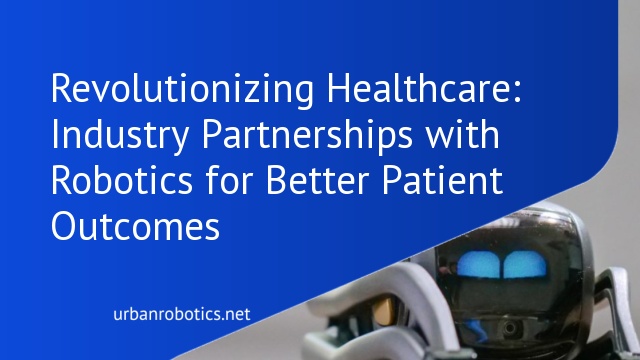Understanding Healthcare Industry Partnerships
Partnerships between the healthcare industry and robotics are essential for advancing medical technologies. These collaborations bring together physicians, engineers, and technologists to develop innovative solutions for patient care. For example, surgical robotics companies partner with hospitals to enhance surgical precision and reduce recovery times. In diagnostics, robotics firms work with medical institutions to create automated systems that provide quicker and more accurate results. These alliances show a commitment to integrating cutting-edge technology for improved patient outcomes.
Pharmaceutical companies also benefit from these partnerships by utilizing robotic systems in drug discovery and development. Robots handle high-throughput screening, speeding up the identification of potential drug candidates. Additionally, healthcare facilities collaborate with robotics firms to streamline hospital operations, including inventory management and patient transportation. These improvements reduce operational costs and increase efficiency, ultimately leading to better care delivery.
Overall, these partnerships demonstrate the healthcare industry’s dedication to leveraging robotics for clinical advancements and operational excellence. They highlight the ongoing efforts to merge technology with human expertise in providing superior healthcare.
The Role of Robotics in Healthcare
Robotics plays a pivotal role in modern healthcare. It transforms patient care, enhances precision, and optimizes operational workflows.
Types of Robotics Used
Hospitals and clinics use several types of robotics to improve healthcare services:
- Surgical Robots: Devices like the da Vinci Surgical System enable minimally invasive procedures with high precision.
- Rehabilitation Robots: These assist patients in physical therapy, providing consistent and tailored exercises.
- Diagnostic Robots: AI-powered robots help in early detection of diseases, improving diagnostic accuracy.
- Pharmacy Robots: Automated dispensing systems streamline the medication distribution process, reducing errors.
- Enhanced Precision: Surgical robots enhance surgical accuracy, resulting in fewer complications and quicker recovery times.
- Increased Efficiency: Automation in hospitals reduces manual workload, allowing healthcare professionals to focus on patient care.
- Improved Diagnostics: AI robots enhance diagnostic capabilities, enabling early and accurate disease detection.
- Cost Savings: Robotics streamline operations, cutting down labor costs and reducing hospital stays.
Key Partnerships Shaping the Industry
Collaborations between healthcare providers and robotics companies are transforming patient care. These partnerships enhance innovation, efficiency, and outcomes.
Notable Collaborations
Google’s parent company Alphabet partnered with Johnson & Johnson, creating Verb Surgical for advanced robotic surgery. IBM teamed up with Medtronic to improve diabetes care using AI and robotics. Intuitive Surgical and Cleveland Clinic collaborate to develop next-gen surgical robots. Siemens Healthineers and Corindus partnered to enhance cardiac procedures with robotic assistance.
Successful Case Studies
Verb Surgical developed a platform that increases precision, reducing operation times and recovery periods. IBM and Medtronic’s project led to better glucose monitoring systems, significantly benefiting diabetic patients. Intuitive Surgical’s partnership with Cleveland Clinic resulted in over 1,500 successful minimally invasive surgeries annually. The Siemens and Corindus alliance enabled safer, more precise cardiac interventions, improving patient outcomes.
Challenges and Considerations
Partnering with robotics in healthcare brings numerous benefits, but it also introduces specific challenges and considerations.
Technological Hurdles
Implementing robotics in healthcare faces significant technological hurdles. The integration of robotic systems with existing medical infrastructure requires substantial investment. Compatibility issues between new robotics equipment and existing healthcare systems can hinder seamless operation. Additionally, maintaining and updating these advanced systems demands specialized expertise. Ensuring data security and protecting patient information also pose significant challenges.
Regulatory Compliance
Robotics in healthcare undergo strict regulatory scrutiny to ensure patient safety and efficacy. Navigating the complex landscape of FDA approvals, CE marking, and other international regulations can prolong deployment timelines. Compliance with data protection laws like HIPAA in the US further complicates implementation. Establishing transparent protocols for monitoring and reporting any adverse events related to robotic systems is essential for maintaining regulatory compliance. Failure to meet these regulatory standards can result in costly delays and potential legal repercussions.
Future Prospects of Robotics Partnerships
Future prospects for robotics partnerships in healthcare are promising, with advancements in AI and automation expected to drive further innovation.
Emerging Trends
AI and machine learning are trending in healthcare robotics. AI algorithms enable predictive diagnostics and personalized treatment plans. Automation is enhancing efficiency in routine tasks, like drug dispensing and patient data management. For example, smart robots are being developed to assist in elder care, providing companionship and timely medication reminders. Telepresence robots are also gaining traction, enabling remote consultations and surgical assistance.
Long-Term Implications
Long-term, robotics partnerships can revolutionize healthcare by reducing costs and improving patient outcomes. Autonomous surgical robots might perform complex procedures with precision, reducing recovery times. Wearable robotic devices could assist in patient rehabilitation, monitoring vitals, and providing real-time feedback. These innovations could alleviate staffing shortages and streamline workflows. However, continuous advancements demand rigorous training and adaptation by healthcare professionals to integrate these technologies effectively.
Conclusion
The collaboration between the healthcare industry and robotics is transforming patient care and operational efficiency. By leveraging AI and automation, we’re witnessing more precise surgeries and enhanced patient monitoring. The future looks bright as these partnerships continue to innovate, paving the way for reduced costs and improved outcomes. However, overcoming technological and regulatory challenges is essential for seamless integration. As we move forward, rigorous training for healthcare professionals will be crucial in maximizing the benefits of these advanced robotic systems. Together, we can revolutionize healthcare and create a more efficient, effective, and patient-centric industry.





